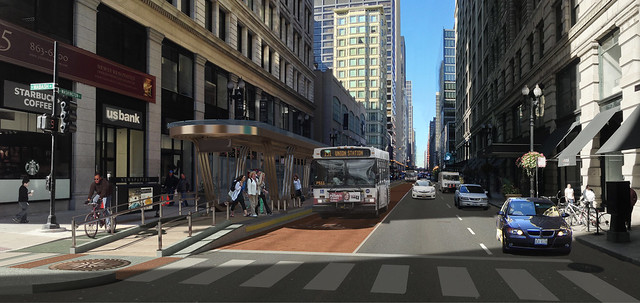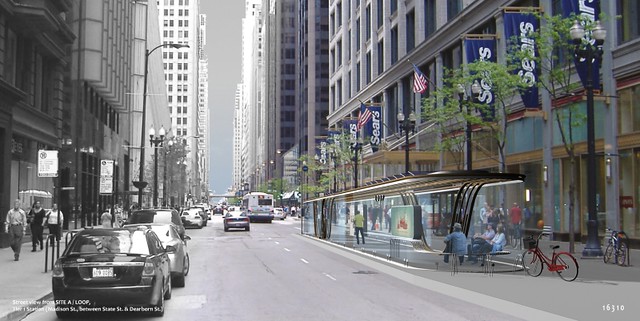The Chicago Department of Transportation recently released a preliminary design for the Loop bus rapid transit corridor’s shelters, heavily influenced by the winner of the NEXT STOP: Designing Chicago BRT Stations contest. Construction on the downtown express bus corridor, featuring dedicated lanes on Washington, Madison, Canal, and Clinton, is slated for this spring, with service launching by the end of the year. Washington and Madison will each get four stations, according to Chris Ziemann, the city’s BRT manager.
The design competition was sponsored by the Chicago Architectural Club and the Chicago Architecture Foundation, with support from the Rockefeller Foundation (a Streetsblog Chicago funder), and drew submissions from 14 different countries. The winning entry, Form vs. Uniform, was submitted by Hesam T. Rostami and Bahareh Atash of Toronto. It features a long, sleek, capsule shape, with transparent glass walls.
According to the designers, while each station would have the same basic footprint, to ease construction, maintenance and access for people with disabilities, the layout of wooden strips incorporated into the roof entrances and walls can be customized to make each shelter unique. Amenities would include solar panels on the roof to provide a portion of the needed power, heat lamps, and bike racks at the rear of the shelter.
Ziemann said CDOT will incorporate many aspects of Rostami and Baharesh’s entry into the final design of the stations. They received $5,000 in prize money but will get no additional compensation. The runners-up won smaller cash awards. “A small investment in the design competition led to a really big payoff in terms of urban design and downtown beautification,” he said. “These are going to be very functional, world-class BRT facilities.”
The mostly glass composition of the design was one of the major selling points, Ziemann said. “We heard from local businesses that ground-level retailers didn’t want to have their storefronts blocked by a big [opaque] bus shelter,” he said. If anything, merchants along the corridor will benefit from the increased foot traffic generated by fast transit service. Proximity to the BRT stops should also attract tenants to nearby office and residential buildings.
The final design will feature level bus boarding from 14”-high platforms. The shelters will be located on islands on Washington and bumpouts on Madison, which will shorten pedestrian crossing distances. The stations will include lighting, seating, Bus Tracker displays, windbreaks inside the shelters, and possibly heat, Ziemann said.
Prepaid boarding is a likely scenario, he said. New York’s Select Bus Service requires customers to buy a ticket from a kiosk at the bus stop before boarding, which is enforced by occasional onboard checks by transit employees. However, it’s more probable that the downtown Chicago stations will use turnstiles to collect fares and control access to the platforms. Multiple bus routes will use the Loop corridor, so it would be impossible for passengers who board in other parts of town to buy a ticket to display during onboard checks.
Streetsblog Chicago readers have asked what’s to keep riders from simply stepping into the street to bypass the turnstiles and then hopping onto the platform. Some cities solve this problem by having sliding doors on the platform that open when the bus arrives. However, Ziemann said that most systems with prepaid boarding only experience five-to-eight-percent fare evasion. “We considered having doors on the platform, but it might be hard to justify the extra cost and maintenance,” he said.
An official unveiling of the station design will take place later this month at the architecture foundation, Ziemann said, adding that he’s happy that the CTA settled on an attractive and practical template for the shelters. “It’s an innovative design for an innovative project.”







